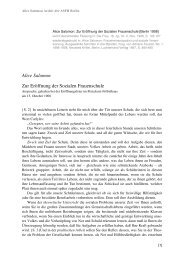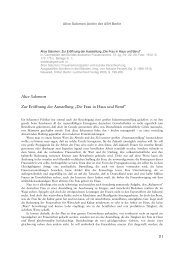Teaching Gender in Social Work - MailChimp
Teaching Gender in Social Work - MailChimp
Teaching Gender in Social Work - MailChimp
Create successful ePaper yourself
Turn your PDF publications into a flip-book with our unique Google optimized e-Paper software.
In the early twentieth century, photography began to play a significant<br />
role <strong>in</strong> the work of <strong>in</strong>tellectuals and social reformers <strong>in</strong> the United States, where<br />
technology has been a significant social factor. We should note an <strong>in</strong>itiative by Paul<br />
Kellogg, who published the journal Survey Graphic from 1921. This illustrated<br />
periodical published articles on important social issues; visual representations,<br />
accord<strong>in</strong>g to Kellogg, were to engage the attention of a wide audience and<br />
to make professional <strong>in</strong>formation suitable for public consumption. He was<br />
very much <strong>in</strong>spired by the follow<strong>in</strong>g idea: “The keynote of the th<strong>in</strong>g (. . .) is<br />
<strong>in</strong>terpretation and we are go<strong>in</strong>g to employ photographs, etch<strong>in</strong>gs, draw<strong>in</strong>gs and<br />
text of a sort which we hope will get a new hear<strong>in</strong>g for the big human concerns<br />
which lie underneath all this technical discussion of social problems.” 45<br />
A photographer who debuted <strong>in</strong> this journal was Lewis H<strong>in</strong>e<br />
(1874–1940). H<strong>in</strong>e studied sociology at the University of Chicago. For<br />
several years he taught sociology at the Ethical Culture School <strong>in</strong> New York<br />
City, where he encouraged students to use photography <strong>in</strong> research. He worked<br />
for The Survey <strong>in</strong> 1906–1908, where he specialised on document<strong>in</strong>g the lives<br />
of <strong>in</strong>dustrial workers; he gradually switched from teach<strong>in</strong>g to photo journalism.<br />
Over the next decade, H<strong>in</strong>e worked closely with organisations lobby<strong>in</strong>g for<br />
social reforms; he was particularly <strong>in</strong>volved <strong>in</strong> efforts by the National Child<br />
Labor Committee to end child labour <strong>in</strong> American <strong>in</strong>dustry. His photographs<br />
of work<strong>in</strong>g kids are famous throughout the world. He also took part <strong>in</strong><br />
document<strong>in</strong>g the work of Hull House <strong>in</strong> Chicago.<br />
Until its f<strong>in</strong>al issue <strong>in</strong> 1952, Survey Graphic was a pioneer <strong>in</strong> debates<br />
on the acute social issues of American society. In the 1930s, a great visual<br />
contribution to efforts to document the Great Depression was made by the<br />
photojournalism of Dorothea Lange, Walker Evans and Russell Lee, who<br />
portrayed the liv<strong>in</strong>g conditions of poor farmers dur<strong>in</strong>g the economic crisis.<br />
In the 1940s, <strong>in</strong> addition to its extensive coverage of the war, Survey Graphic<br />
made the issue of race visible <strong>in</strong> two highly regarded special issues: “Color: The<br />
Unf<strong>in</strong>ished Bus<strong>in</strong>ess of Democracy” (1942) and “Segregation: Color Pattern<br />
From the Past — Our Struggle to Wipe it Out” (1947). 46<br />
45<br />
Kellogg, cited <strong>in</strong>: Cara F<strong>in</strong>negan <strong>Social</strong> Welfare and Visual Politics: The Story of Survey Graphic, available at<br />
http://newdeal.feri.org/sg/essay01.htm<br />
46<br />
Ibid.<br />
76














